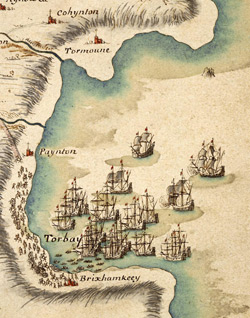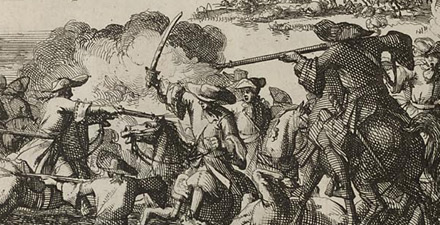England and the Netherlands: the ties between two nations > The Glorious Revolution
Charles II, King of England, Scotland and Ireland, died in 1685. Although he left a whole host of natural children, no legitimate heir to the throne was born of his marriage with the Portuguese Catharine of Bragança. His brother James II succeeded him to the throne, but the new King’s religious zeal and the measures he took in favour of Roman Catholicism rubbed the Protestants up the wrong way. As a matter of fact, his plea in favour of religious tolerance did not greatly differ from the view taken by Charles II, but the fact that James was openly a militant catholic made him much more threatening. In 1688, when his second wife, Maria of Modena, gave birth in 1688 to a little boy who was christened James Francis Edward (later the ‘Old Pretender’), the Protestants saw their hope – that James’ protestant daughter Maria would ever succeed her father - vanish. Instead, a catholic dynasty threatened to sit firmly on the English throne. The birth of the little prince was surrounded by mystery. Rumour had it that Maria of Modena was too old to have a child and that the baby had been smuggled into the delivery room by Jesuits.

When, against the dissolved Parliament’s will, James promulgated laws giving Roman Catholics greater religious freedom, some members of the House of Commons and church dignitaries asked William III to intervene. William was at war with France and saw in the request an excellent opportunity to get England on his side. The States General having given their assent, William III landed near Brixham in Devon with an army of 15,000 men on 5 November 1688. James’ army deserted and he himself fled to Kent, where he was taken prisoner. He fled to France after having been liberated.
In 1689, the Parliament convened and came to the conclusion that James had renounced the throne by fleeing to France. William and Mary were invited to reign together as King and Queen This triggered a Jacobean rebellion in Scotland, and James succeeded in mobilizing the Roman Catholics in Ireland as well. In 1690, William III was able to defeat James II once and for all at the Battle of Boyne in Ireland.

In Northern Ireland, ‘King Billy’ remains the hero of the protestant loyalists, who celebrate his victory over the Catholics at the Battle of Boyne every year on 12 July with marches and bonfires. These festivities and the marches of the Orange Order are a thorn in the side of the Roman Catholics and passions sometimes blaze in July, even though the sectarian violence of ‘The Troubles’ has now officially come to an end. For the sake of convenience, modern loyalist admirers forget that ‘King Billy’ had countless Roman Catholics in his armies and that the pope supported him as an ally in the conflict he had with the French King Louis XIV (with whom James entertained close relations).
Following his victory in Ireland, William paid his first visit to the Netherlands after the Glorious Revolution. A triumphal entry had been prepared for him in The Hague where he was welcomed by the city fathers and the States of Holland and where his heroic deeds had been symbolized by triumphal arches.
> Read on: Het Loo Palace
< Go back to: Willem III: King-stadholder
